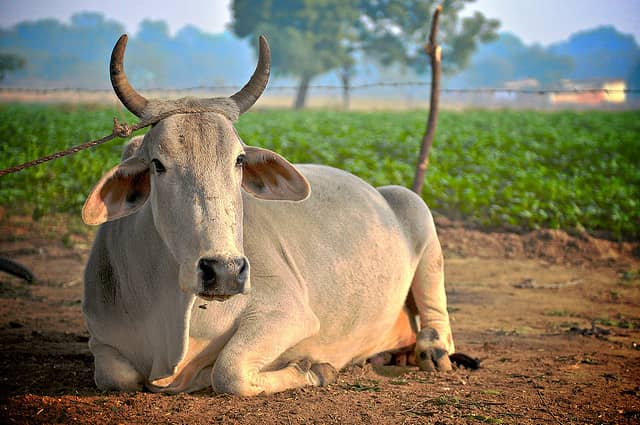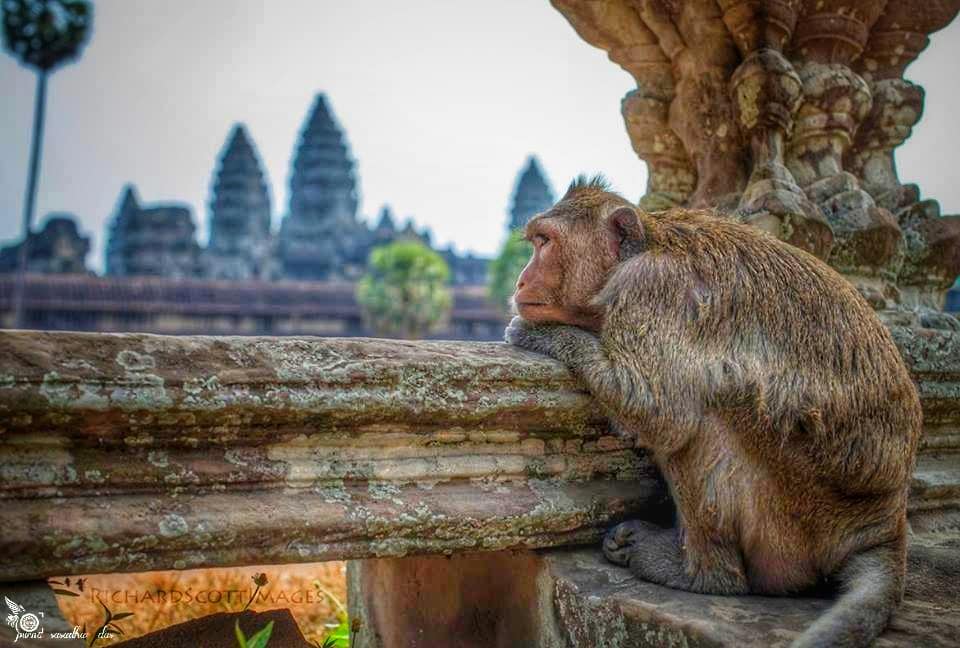Mahanidhi Madan Gopal Das
Glories of Sri Krishna’s Nandagrama (continued from part 5)
IV. Eternal Associates of Sri Krishna
Although all the people of Nandishvara appear to exhibit temporary qualities such as youth and old age to facilitate their individual rasas, they are actually all liberated souls. Their so-called youth and old age are beyond the transformations of time.
Nanda Maharaja, the king of Vrindavana, resides in this town as the embodiment of paternal affection. Manifesting the pure nature of the soul, he is the essence of all auspiciousness, a veritable island amidst an ocean of bliss. By assuming the role of Krishna’s father, which he plays eternally, he has become endowed with all auspicious qualities. His wife Yasoda resides in Nandishvara as the embodiment of maternal affection, and a desire creeper awarding the darsana of Krishna. As a beautiful flower spreads its fragrance in all directions, the effulgence of Yasoda’s fame illuminates her entire dynasty.
Hundreds of honest and gentle cowherd men live in this capital city. They are not attached to their families, but they are completely attached to Krishna. Although they diligently care for their domestic animals and maintain themselves by trading in milk and yogurt, they exist totally in the spiritual world. A few of the cowherd men are intimate relatives of Nanda Maharaja, but all them are closely related to each other.
The husbands embody religious principles and the wives embody devotional feelings. Their sons are Krishna’s cowherd boyfriends and their daughters are His dearest lovers. Like the four Kumaras, all of Krishna’s friends are eternally youthful. As flocks of birds decorate a forest, Krishna is surrounded by friends of the same age. Krishna and His friends have a very close and intimate relationship resembling the intimacy of flowers strung on a thread.
The blissful boyfriends of Krishna have clear eyes and brilliantly shining hair. With their musk and sandal scented bodies, smiling lotus faces, well-proportioned ears, elegantly shaped noses, handsome and resplendent necks, long, beautiful arms, and their chests are always swelling with happiness. The waists of the boys are as firm as the sides of an elephant. Krishna’s friends have very strong thighs that give joy to everyone. They walk on their bare feet, which are as tender as the rays of the moon. The cowherd boys of Vrindavana far surpass the demigods, and they exist eternally as Krishna’s beloved associates. Subala, Sridama, Sudama and Vasudama are some of Krishna’s intimate boyfriends.
Now the intimate girlfriends of Krishna will be described. The delicate feet of Krishna’s gopis resemble poetry full of wonderful rhymes. Their slender ankles move with the speed of the mind. The thighs of the gopis conquer the splendor of the broad trunks of banana trees, and the sweetness of their graceful hips is very attractive. They have charming bellies, delightful navels and thin waists.
They have long graceful arms, and their throats have three attractive lines resembling a conch shell. They have beautiful noses, captivating eyes and beautiful ears that always drink the sweet nectar of hari-katha. They sport splendid curls and attractive hairstyles.
Sri Radha reigns as the best of Krishna’s beloveds. This beautiful young girl is resplendent with all good qualities such as mercy, sweetness, and vitality. As the crest-jewel among Krishna’s lovers, Kishori possesses all ornaments, and all types of emotional mellows. Radhika is a golden flower in a garden of prema; a lightning flash in a cloud of sweetness; or a golden line on a testing stone of beauty.
Radhika is the light of the moon of bliss. Her slender arms conquer the pride of Cupid. Radharani is the splendorous essence of the ocean of loveliness, and the enchanting smile of those intoxicated by love. She is a mine of the sixty-four arts, and the precious crest-jewel of all good qualities. Radhika’s complexion is more golden than a thousand Parvatis.
Radhika is also called Syama, which means that Her transcendental body is warm in the winter and cool in the hot season. Her breasts are firm, full, slightly raised, and very beautiful. Although existing since time immemorial, Radhika is an ever-fresh young girl. Radharani is the epitome of beauty and the life and soul of Her girlfriends.
Though just an innocent young girl, Radharani controls all the goddesses of fortune in the universe. Learned pandits call Her Maha-Laksmi, tantrics call Her Lila-sakti and bhaktas call Her Hladini-sakti. Radhika is ornamented by Her dear friends who display all good qualities and move as Radha’s reflections.
Among all the young gopis, there is also one group leader named Candravali, who is the crest jewel of dalliance. She bestows the bliss of a million moons. Candravali has all good qualities, and her feminine form is the natural embodiment of beauty. Candravali is the essence of all rasa who gives bliss to all. Padma, Saibya, and others serve as her dearest companions. Although she is very prominent, Candravali is merely another gopi group leader amongst the Vraja gopis. There is another gopi group leader named Syama-sakhi, who is very dear to Radhika.
All the brahmanas living in Nanda Baba’s capital embody the principles of bhagavata dharma. They are extremely merciful, and always display sense and mind control, tolerance, and renunciation. With great skill they recite sastras like the Bhagavata, and always study the Narada Pancaratra and other Vedic works that corroborate the Bhagavata. They alone qualify for Nanda Maharaja’s charity, and only they perform the appropriate rituals and ceremonies.
Some of these brahmanas worship the aishvarya aspect of Krishna, and others adore the madhurya feature of the Lord. After thorough study of the eighteen branches of knowledge they have become genuinely peaceful and fixed in their own realizations. It is not surprising that they have never been defeated in debate. Though possessing abundant wealth, they always remain humble and exhibit gentle behavior, friendship, kindness, and compassion to one and all.
Although the oil-sellers, tambula salesmen, goldsmiths, pot makers, weavers, and blacksmiths have spiritual forms, they behave like ordinary humans. Commanding the respect of all pious men, they freely distribute their wealth wherever needed. They do not have material bodies, nor do they experience the sufferings of ordinary mortals.
Surrounding the town of Nandishvara are many rows of small forest groves filled with varieties of multi-hued trees, dangling creepers, kunjas and bowers. The vanadevis wander hand in hand along the forest paths softened from the sap constantly dripping from the trees. The whole forest is sweetly scented from the juice of the kakkola berries spilling out of the mouths of the wild rams as they contentedly ruminate. The air is also scented from the aromatic bark of the deva daru trees rubbed off by the horns of wild buffaloes.
The sides of the hills are strewn with tree branches broken by the tusks of the wild baby elephants. And the ground is covered with bunches of half-eaten grapes scattered by families of monkeys. The aborigine women wander through the thick forest groves.
There are many other forests such as Kamyavana and Lohavan, full of trees and exotic vegetation. The lakes are full of crystal clear water and covered with water lilies. White, blue and red lotuses lie scattered throughout these forests. These lakes resound with singing herons, ducks, swans, cranes, ospreys, and cakravakas.
Vraja-mandala, although completely spiritual, is situated within the material world. Thus those with mundane vision see Vrindavana as a material place. Svatantra Bhagavan Sri Krishna freely chose to appear in this world in Vrindavana as the baby son of Nanda and Yasoda, the eternal embodiments of parental affection. Since Krishna is the origin of all avataras and the ocean of all pastimes, why does He perform pastimes in the material world? Simply to give pleasure to His devotees.
To show the world the astonishing depths of their parental affection, Krishna appeared as the son of Nanda and Yasoda. Accepting their care and attention, the omnipotent Lord covered His majesty with an unprecedented sweetness. By exhibiting all the different stages of boyhood such as kumara, pauganda, and kaisora, the Supreme Lord Krishna appeared like an ordinary human being. But throughout these stages Krishna remained in His original form as the Supreme Personality of Godhead.
Although madhurya rasa is predominant one in Vrindavana, the previous verse has only mentioned parental affection. The reason for this is that all of Krishna’s pastimes with the cows, gopas, and gopis also go on eternally in the spiritual world. But Krishna’s babyhood pastimes and the killing of demons occurs only in the Gokula in the material world. Thus one should understand that the sweetness of bhauma-lila is not available in the spiritual world.
Kaviraja Sri Karnapura Goswami’s Ananda Vrindavana Campu ki jai!
Radha-Govinda Vraja Lilas ki jai! Jai Jai Sri Radhe!
All parts of Krishna Nectar Lilas can be found here.





